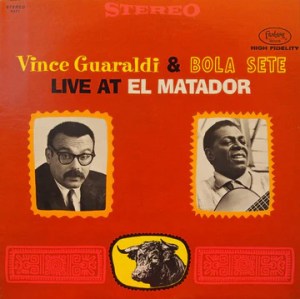More Vince Guaraldi
More Live Recordings of Interest
- This early Fantasy pressing of Live at El Matador earned excellent Double Plus (A++) grades or BETTER from start to finish
- Both of these sides are rich, clean, clear, lively and spacious with little of the grittiness that plagues the average copy
- This is the third and final collaborative effort between Vince Guaraldi and Bola Sete, and if you’re a fan of either, you should find much to enjoy here
- “… a virtuoso guitar performance; even as a living room listening experience, Sete demonstrates the mastery that so impressed club patrons.” – Five Cents Please
This vintage Fantasy pressing has the kind of Tubey Magical Midrange that modern records can barely BEGIN to reproduce. Folks, that sound is gone and it sure isn’t showing signs of coming back. If you love hearing INTO a recording, actually being able to “see” the performers, and feeling as if you are sitting in the studio with the band, this is the record for you. It’s what vintage all analog recordings are known for — this sound.
If you exclusively play modern repressings of vintage recordings, I can say without fear of contradiction that you have never heard this kind of sound on vinyl. Old records have it — not often, and certainly not always — but maybe one out of a hundred new records do, and those are some pretty long odds.
What The Best Sides Of Live At El Matador Have To Offer Is Not Hard To Hear
- The biggest, most immediate staging in the largest acoustic space
- The most Tubey Magic, without which you have almost nothing. CDs give you clean and clear. Only the best vintage vinyl pressings offer the kind of Tubey Magic that was on the tapes in 1966
- Tight, note-like, rich, full-bodied bass, with the correct amount of weight down low
- Natural tonality in the midrange — with all the instruments having the correct timbre
- Transparency and resolution, critical to hearing into the three-dimensional studio space
No doubt there’s more but we hope that should do for now. Playing the record is the only way to hear all of the qualities we discuss above, and playing the best pressings against a pile of other copies under rigorously controlled conditions is the only way to find a pressing that sounds as good as this one does.
Copies with rich lower mids and nice extension up top did the best in our shootout, assuming they weren’t veiled or smeary of course. So many things can go wrong on a record! We know, we’ve heard them all.
Top end extension is critical to the sound of the best copies. Lots of old records (and new ones) have no real top end; consequently, the studio or stage will be missing much of its natural air and space, and instruments will lack their full complement of harmonic information.
Tube smear is common to most vintage pressings. The copies that tend to do the best in a shootout will have the least (or none), yet are full-bodied, tubey and rich.
What We’re Listening For On Live At El Matador
- Energy for starters. What could be more important than the life of the music?
- The Big Sound comes next — wall to wall, lots of depth, huge space, three-dimensionality, all that sort of thing.
- Then transient information — fast, clear, sharp attacks, not the smear and thickness so common to these LPs.
- Tight punchy bass — which ties in with good transient information, also the issue of frequency extension further down.
- Next: transparency — the quality that allows you to hear deep into the soundfield, showing you the space and air around all the instruments.
- Extend the top and bottom and voila, you have The Real Thing — an honest to goodness Hot Stamper.
Size and Space
One of the qualities that we don’t talk about on the site nearly enough is the SIZE of the record’s presentation. Some copies of the album just sound small — they don’t extend all the way to the outside edges of the speakers, and they don’t seem to take up all the space from the floor to the ceiling. In addition, the sound can often be recessed, with a lack of presence and immediacy in the center.
Other copies — my notes for these copies often read “BIG and BOLD” — create a huge soundfield, with the music positively jumping out of the speakers. They’re not brighter, they’re not more aggressive, they’re not hyped-up in any way, they’re just bigger and clearer.
And most of the time those very special pressings are just plain more involving. When you hear a copy that does all that — a copy like this one — it’s an entirely different listening experience.
TRACK LISTING
Side One
I’m A Loser
El Matador
People
Nobody Else
More
Side Two
Favela
Black Orpheus Suite
AMG 4 Stars Review
Despite the co-billing, Sete only appears on the second half of the album, leaving the Guaraldi trio to knock out a crisp series of standard pop tunes of the time (“I’m a Loser,” “People,” “More”) and two memorable Guaraldi originals (“Nobody Else,” “El Matador”) in its patented mainstream and Latin modes in the first half. When Sete turns up, the set goes all-Brazilian as the two display their blended, intertwined teamwork for the third and last time on records in “Favela” and a brace of tunes from Black Orpheus. Though it is only a partial collaboration, this album has a bit more fire than their previous ones, possibly due to the live factor.
